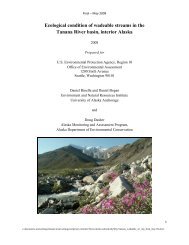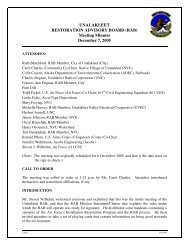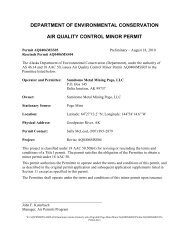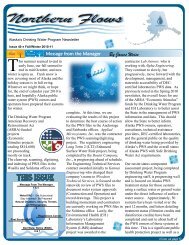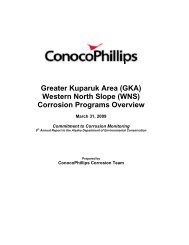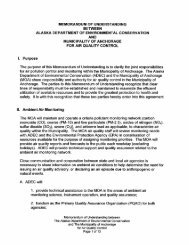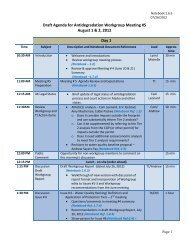2012 Ocean Ranger Guidebook Revision 3-7-12 - Alaska ...
2012 Ocean Ranger Guidebook Revision 3-7-12 - Alaska ...
2012 Ocean Ranger Guidebook Revision 3-7-12 - Alaska ...
You also want an ePaper? Increase the reach of your titles
YUMPU automatically turns print PDFs into web optimized ePapers that Google loves.
<strong>20<strong>12</strong></strong> <strong>Ocean</strong> <strong>Ranger</strong> <strong>Guidebook</strong> 3-7-<strong>12</strong><br />
Background: For vessels with continuous (or automatic) discharges the regulations were written to<br />
divide up the voyage with each port of call. Otherwise the discharge log would be one entry potentially.<br />
For continuous dischargers the 24 clock was required to differentiate between AM and PM on the logs.<br />
These regulations only apply to continuous or automatic dischargers, either stationary or underway.<br />
Underway only dischargers only need to be checked for the regulations that apply to underway vessels<br />
(18 AAC 69 (c) 1,2,4). Continuous or automatic discharges are those where the systems is pumping<br />
continuously (continuous), or where the system pumps without an operator’s direct input, such as from<br />
an AWTS tank where discharges are pumped every time the tank reaches a particular level.<br />
Citation: 18 AAC 69.050. Treated sewage, graywater, and other wastewater discharge records and<br />
report.<br />
(c) For an automatic or continuous discharge, in port, at anchorage, or underway, of treated sewage,<br />
graywater, or other wastewater into the marine waters of the state, the records required by AS<br />
46.03.465(a) must describe for each voyage<br />
(1) the daily estimated volume of discharge by type;<br />
(2) a description of how the daily volume by discharge type was estimated;<br />
(3) for each stay that a vessel makes at an anchorage or dock, the<br />
(A) date of the stay;<br />
(B) time expressed in a 24-hour clock format at the beginning and end of each docking<br />
or anchorage;<br />
(C) latitude and longitude of the stay; and<br />
(D) estimated average flow rate of discharge by type of discharge; and<br />
(4) for each vessel route while the vessel is underway between each stay identified in (3) of this<br />
subsection, the<br />
(A) dates while en route;<br />
(B) time expressed in a 24-hour clock format at the beginning and end of each vessel<br />
route;<br />
(C) vessel’s average speed; and<br />
(D) estimated average flow rate of discharge by type of discharge.<br />
Job Aid Item: 1.3.d<br />
Text: Onboard records describe how the daily volumes of how discharge are calculated/estimated/or<br />
metered IAW 18 AAC 69.050(c)(2)(only for continuous or automatic discharge).<br />
What to check for: Check discharge logs, if a vessel has continuous or automatic discharges in <strong>Alaska</strong><br />
then the discharges must be calculated by type. The method of calculation or metering must be<br />
described. This would likely be in the discharge log instructions either in the logbook or separately. The<br />
methods must be listed in the seasonal report.<br />
Background: Operators need to identify how wastewater effluent volumes were measured.<br />
Citation: 18 AAC 69.050 (c)<br />
29






